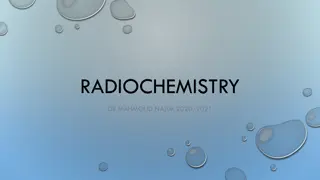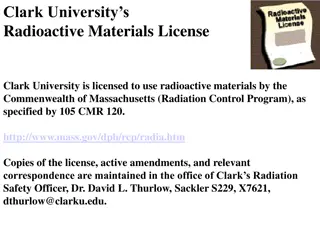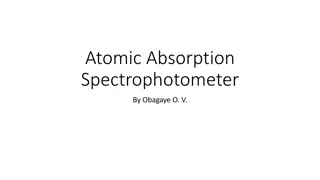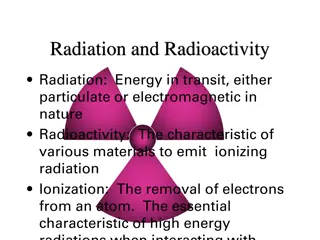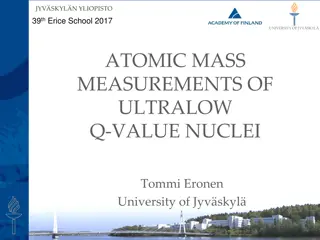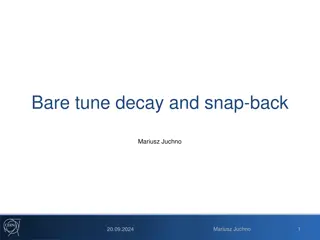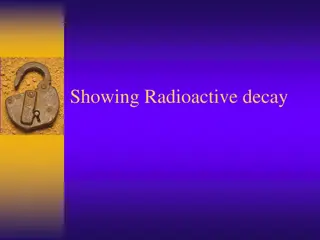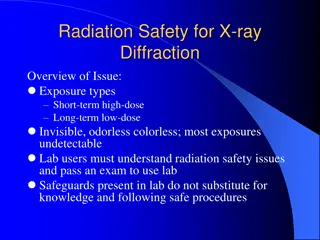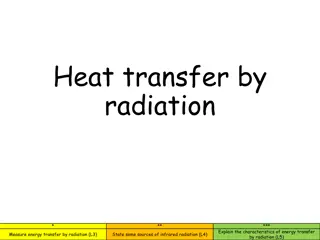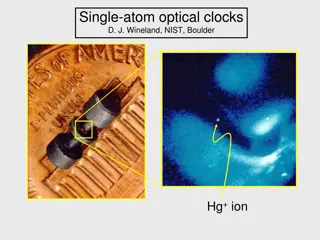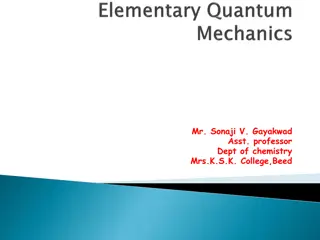Integration of Atomic Radiation Energies and Emission Probabilities in Decay Data Sets
Proposal by Tibor Kibdi and Filip Kondev to include absolute atomic radiation energies and emission probabilities in decay data sets. They emphasize the need for energy and intensity data to be computer-readable and use standard notation. The inclusion of atomic relaxation data into ENSDF is discussed, along with a correlation study on energy deposition and molecular damage from Auger electrons. The content also touches on notation guidelines from IUPAC and provides insights into ultra-low energy electron interactions with DNA.
Download Presentation

Please find below an Image/Link to download the presentation.
The content on the website is provided AS IS for your information and personal use only. It may not be sold, licensed, or shared on other websites without obtaining consent from the author. Download presentation by click this link. If you encounter any issues during the download, it is possible that the publisher has removed the file from their server.
E N D
Presentation Transcript
Proposal Inclusion of absolute atomic radiation energies and emission probabilities in decay data sets Tibor Kib di (ANU) and Filip Kondev (ANL) Tibor Kib di, Dep. of Nuclear Physics, Australian National University NSDD April 2015, IAEA, Vienna
Atomic Data in ENSDF BrIccEmis (Dec-2014) Need to Contain energy and intensity for the users Readable by computer codes Use standard notation Transition energies: Auger 300 k of 453 types X-ray: 17.4 k of 55 types Tibor Kib di, Dep. of Nuclear Physics, Australian National University NSDD April 2015, IAEA, Vienna
Notation Comment Notation:from IUPAC International Union of Pure and Applied Chemistry Based on initial and final atomic levels involved Group sub-shells to reduce number of transitions Summed decay rates Use the mean transition energy for the group X-rays Auger electrons K-L1-L2 K-L3 L (for L1-M2, L3-O4) KLL (for K-L1-L1, K-L3-L3) But not for K K 1 for K-L3 K 2 for K-L2 K for K-M3&K- M2 KLX (X=M1 .,N1 .) KXY (X&Y=M1 .,N1 .) Tibor Kib di, Dep. of Nuclear Physics, Australian National University NSDD April 2015, IAEA, Vienna
Inclusion of atomic relaxation data into ENSDF 111CDSAD 111CDSAD AKtot [0.0428 25]$ [0.0428 25]$ ... ... 111CDSXD 111CDSXD Xtot Xtot=10.843 [1.855 17]$ =10.843 [1.855 17]$XKtot [0.2415 12]$ [0.2415 12]$ ... ... 111CD L 0.0 1/2+ STABLE 111CD L 0.0 1/2+ STABLE New ENSDF record type D (col. 8) and S (col. 6) with A (Auger) and X (X-ray) in column 7; 16 records for 111In Only appears in DECAY data sets just before the ground state level record Each entry: (a) Radiation group ( Aktot= ); (b) Mean energy in keV; (c) Intensity (on the same scale as gammas; [RI DRI] ) Intensities cut off: 0.0001/decay Detailed spectra (list and figure) stored on the ENSDF file server Uncertainties: need further study how to deduce AKtot=20.298 [0.1526 23]$AKLL=19.223 [0.1058 17]$AKLX=22.464 =20.298 [0.1526 23]$AKLL=19.223 [0.1058 17]$AKLX=22.464 XKtot=23.706 [0.836 34]$XKL2=23.058 =23.706 [0.836 34]$XKL2=23.058 Tibor Kib di, Dep. of Nuclear Physics, Australian National University NSDD April 2015, IAEA, Vienna
Correlation between energy deposition and molecular damage from Auger electrons A case study of ultra-low energy (5 18 eV) electron interactions with DNA M. Rezaee, D.J. Hunting, L. Sanche, Univ. de Sherbrooke, Sherbrooke, Qu bec, Canada Med. Phys. 41 (2014) 072502 1.2 2.4 8.4 2014Rezaee (isolated atom) BrIccEmis (isolated atom) BrIccEmis (fast neutralisation) 1.0 0.8 N(5-18 eV) per 125I EC decay 0.6 N(Eo) 0.4 Nanodosimetric model (V=4.3 nm3!) based on the medical internal radiation dose (MIRD) schema (M. Michaud et al. Phys. Rev E 87 (2013) 032701) 0.2 0.0 0 5 10 15 20 Eo [eV] Tibor Kib di, Dep. of Nuclear Physics, Australian National University 8-Dec-2014, IAEA CRP
Inclusion of atomic relaxation data into ENSDF # Auger electron spectrum calculated with BrIccEmis (23-Sep-2012) # 2012Le09 - B.Q. Lee, T. Kib di, A.E. Stuchbery, K.A. Robertson, Comput. Math. Meth. Med. (2012) 651475. # ENSDF file: 111In_EC.ens # Number of MC events: 1.00E+06 # Energy [eV] Prob/Decay Transition 0.2564314665505663E-02 0.2000000E-05 N3 O1 O1 0.3382129158126190E-02 0.2000000E-05 M3 M4 N2 0.8580056135542691E-02 0.1000000E-05 N1 N4 N4 0.1006155717186630E-01 0.1300000E-04 M3 M5 N3 0.1251549087464809E-01 0.1000000E-05 M3 M4 N3 0.1370093508739956E-01 0.3000000E-05 N1 O1 O1 0.1575733287609182E-01 0.1000000E-05 M1 M3 N2 0.1615695515647531E-01 0.1600000E-04 N3 N5 O1 0.1823203373351134E-01 0.6000000E-05 M3 M5 N3 0.1938508616876788E-01 0.2000000E-05 M3 M5 N3 0.2405271388124675E-01 0.1000000E-05 N1 N5 N5 0.2876172141986899E-01 0.1000000E-05 M3 M4 N3 0.2945651562185958E-01 0.2000000E-05 M3 M5 N3 0.2977057074895129E-01 0.3000000E-05 M3 M5 N3 0.3186989165260457E-01 0.2000000E-04 N1 N4 N4 0.3758543072035536E-01 0.4000000E-05 N1 N5 N5 0.3957409400027245E-01 0.1800000E-03 N3 N4 O1 0.4244740249123424E-01 0.2000000E-05 M3 M5 N3 Auger electron energy spectrum for plotting & input for MC simulations Tibor Kib di, Dep. of Nuclear Physics, Australian National University NSDD April 2015, IAEA, Vienna
S_G records Current record created by BrIcc 71GES G KC=169.5 $LC=32.7 $MC=5.03$ 71GES G KC=169.5 $LC=32.7 $MC=5.03$ Modified records, ICC ratios not changed 71GES G KC=12.33 [169.5 25]$LC=22.07 [32.7 5]$MC=23.27 [5.03 8]$ 71GES G KC=12.33 [169.5 25]$LC=22.07 [32.7 5]$MC=23.27 [5.03 8]$ Energy ICC DICC Tibor Kib di, Dep. of Nuclear Physics, Australian National University NSDD April 2015, IAEA, Vienna





